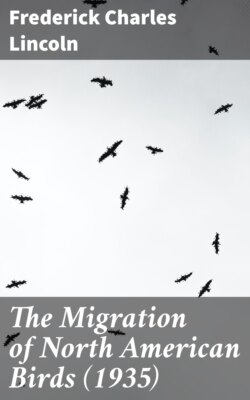Читать книгу The Migration of North American Birds (1935) - Frederick Charles Lincoln - Страница 3
INTRODUCTION
ОглавлениеWhere do the birds go each fall that have nested in our dooryards and frequented the neighboring woods, hills, and marshes? Will the same ones return again to their former haunts next spring? What dangers do they face on their round-trip flight and in their winter homes? These and other questions on the migratory habits of birds puzzle the minds of many who are interested in the feathered species, whether it be the farmer who profits by their tireless warfare against the weed and insect pests of his crops, the bird student who enjoys an abundance and variety of feathered inhabitants about him, or the hunter who wants a continuation from year to year of the sport of wild-fowling. Lack of information on the subject may mean the loss of an important resource by unconsciously letting it slip from us. Ignorance of the facts may be responsible for inadequate legal protection for such species as may urgently need it. More general knowledge on the subject will aid in the perpetuation of the various migrants, the seasonal habitats of some of which are in grave danger from man's utilization, sometimes unwisely, of the marsh, water, and other areas they formerly frequented.
The migrations of birds were probably among the first natural phenomena to attract the attention and intrigue the imagination of man. Recorded observations on the subject date back nearly 3,000 years, to the times of Hesiod, Homer, Herodotus, Aristotle, and others. In the Bible are several references to the periodic movements of birds, as in the book of Job (39:26), where the inquiry is made: "Doth the hawk fly by Thy wisdom and stretch her wings toward the south?" Jeremiah (8:7), wrote: "The stork in the heavens knoweth her appointed time; and the turtle [dove], and the crane, and the swallow, observe the time of their coming." And the flight of quail that saved the Israelites from starvation in their wanderings in the wilderness of Sinai is now recognized as a vast movement of migratory quail (Coturnix coturnix) between their breeding grounds and their winter home in Africa.
Throughout the ages the return flights of migratory birds have been important (1) as a source of food after a lean winter, and (2) as the harbinger of a change in season. The arrival of certain species has been heralded with appropriate ceremonies in many lands, and among Eskimo and other tribes the phenomenon to this day is the accepted sign of the imminence of spring and of warmer weather. The pioneer fur traders in Alaska and Canada offered rewards to the Indian or Eskimo who saw the first goose of the spring, and all joined in jubilant welcome to the newcomer.
Always hunted for food, the large flocks of ducks and geese became objects of the enthusiastic attention of an increasing army of sportsmen as the North American Continent became ever more thickly settled. Most of the nongame species were found to be valuable also as allies of the farmer in his never-ending warfare against weed and insect pests. The need for laws protecting the valuable game and nongame birds and for regulated hunting of the diminishing game species followed as a natural course. In the management of this wildlife resource it has become obvious that continuous studies must be made of the food habits of the various species, their environmental needs, and their travels. Hence bird investigations are made by the Biological Survey, the Bureau charged by Congress under the Migratory Bird Treaty Act with the duty of protecting those species that in their yearly journeys pass back and forth between the United States and Canada.
For half a century the Biological Survey has been collecting data on the interesting and important phenomenon of the migration of North American birds. The field men of the Bureau have gathered information concerning the distribution and seasonal movements of the different species in many extended areas, from the Arctic coast south to the pampas of Argentina. Supplementing these investigations is the work of hundreds of volunteer ornithologists and bird students throughout the United States and Canada, who each year, spring and fall, forward to the Bureau reports on migrations observed in their respective localities. Added, to the mass of data thus assembled is a rapidly growing file of records of birds that have been banded and of the subsequent recovery of the marked individuals.
These data, together with other carded records gleaned by the Biological Survey from a vast literature, constitute a series of files that now contain well over 2,500,000 entries, easily the greatest existing accumulation of information pertaining to the distribution and movements of North American birds. Not only do the facts thus assembled form the basis of regulatory action for the protection of the birds, but they also make it possible to publish scientific accounts of the ranges and migrations of the different species. They furnish the basis of this publication.
The several important bird-protective measures adopted by State and Federal Governments, particularly those having as their objective the conservation of the migratory song, insectivorous, and game species, can be effective only if they have intelligent public support. To increase such support, information must be more generally available on that little understood but universally fascinating subject of bird migration. A brief presentation of facts on the migratory habits of the birds, scientifically gathered by the Bureau of Biological Survey over many years, will be helpful to bird-study classes, to conservation organizations, and to farmers and others individually interested in the welfare of the birds.
